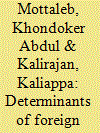|
|
|
Sort Order |
|
|
|
Items / Page
|
|
|
|
|
|
|
| Srl | Item |
| 1 |
ID:
101086


|
|
|
|
|
| Publication |
2010.
|
| Summary/Abstract |
This paper examines the efficiency of the Thai banking sector from 1999 to 2008 by using the data envelopment analysis (DEA) method. The results indicate that inefficiency in the sector stems mainly from scale rather than pure technical efficiencies. The findings suggest that small banks are most efficient, while medium-sized banks have been the least efficient banking group. Domestic banks have been relatively more efficient than their foreign bank peers, which can be attributed largely to a higher pure technical efficiency (PTE) level. The results from the multivariate regression analysis suggest that banks with higher loans intensity and which are relatively better capitalised tend to exhibit higher efficiency levels. On the other hand, credit risk is negatively related to bank efficiency. The empirical findings suggest that the recent global financial crisis exerts a negative impact on the efficiency of Thai banks.
|
|
|
|
|
|
|
|
|
|
|
|
|
|
|
|
| 2 |
ID:
101085


|
|
|
|
|
| Publication |
2010.
|
| Summary/Abstract |
Several studies reveal that organisational databases have significant errors (Klein, 2000; Morgenstern, 1963; Musgrove, 1974). Attributed to this, researchers, policy makers and other users are obliged to authenticate collected data for its randomness before usage in order to prevent problems caused by erroneous data. The objective of this study is to establish random databases for furthering scientific analysis. Motivation for the study comes from the circumstances where scientific inquiry is juxtaposed with different databases or sources of the same unit of inquiry having different datasets. This study uses three databases used by the Indian government, namely, the Economic Survey, Reserve Bank of India and United Nations Conference for Trade and Development (UNCTAD) on FDI inflows to the Indian economy (1991-2007), to establish randomness and detect data errors and inaccuracies. Applying the Run test method, the study established that all three datasets are random. The Chi-square test supports the dataset used by the Economic Survey and not other databases. Also, the Economic Survey dataset follows Benford's distribution and its Pearson correlation coefficient is higher than the other sources of data. In general, the Economic Survey database does better in terms of data accuracy compared to other datasets for the period of study.
|
|
|
|
|
|
|
|
|
|
|
|
|
|
|
|
| 3 |
ID:
101084


|
|
|
|
|
| Publication |
2010.
|
| Summary/Abstract |
By bridging the gap between domestic savings and investment and bringing the latest technology and management know-how from developed countries, foreign direct investment (FDI) can play an important role in achieving rapid economic growth in developing countries. Developing countries have not been considered as favourable destinations for FDI as developed countries. Moreover, among the developing countries a few, such as China, India, Nigeria and Sudan, are the major recipients of FDI, with the rest vying for the scraps. Using panel data from 68 low-income and lower-middle income developing countries, this article strives to identify the factors that determine FDI inflow to developing countries. Based on a comparative discussion focussing on why some countries are successful in attracting FDI, the article demonstrates that countries with larger GDPs, higher GDP growth rates, higher proportion of international trade and a more business-friendly environment are more successful in attracting FDI.
|
|
|
|
|
|
|
|
|
|
|
|
|
|
|
|
| 4 |
ID:
101087


|
|
|
|
|
| Publication |
2010.
|
| Summary/Abstract |
Disparities between social groups transcend the boundary of current generation and perpetuate across future generations as well. This is manifested as low intergenerational mobility in terms of both education and occupation in developing countries in general, and among specific ethnic groups within those countries in particular. This paper examines the extent of intergenerational mobility in both educational and occupational attainments for diverse social groups in India to understand the inertia of disparities prevalent. Results indicate strong intergenerational stickiness in both educational achievement and occupational distribution among the scheduled castes and tribes who have been discriminated against historically. Occupational mobility is lower than educational mobility indicating that educational progress is not being transformed to occupational improvement and bringing up the possibility of discrimination in the labour market. This also brings to the fore the fact that historical social exclusion has had a long-run effect and the inertia is quite strong.
|
|
|
|
|
|
|
|
|
|
|
|
|
|
|
|
| 5 |
ID:
101088


|
|
|
|
|
| Publication |
2010.
|
| Summary/Abstract |
This paper examines spatial integration of food grain markets in India. Using the maximum likelihood method of cointegration, it investigates whether regional food grain markets within and across states are spatially linked or not. The cointegration tests provide evidence in favour of spatial integration of the regional food grain markets. Even though regional markets are geographically dispersed, prices across different market centres within and across states have exhibited long-run spatial linkages, suggesting that all the exchange locations are integrated and that prices provide relevant market signals. There are, however, regional variations in the extent of market integration, which could be due to regional disparities in infrastructure and the institutional structure of food grain markets. The results have important implications for agricultural price policy and the food market liberalisation programme.
|
|
|
|
|
|
|
|
|
|
|
|
|
|
|
|
|
|
|
|
|